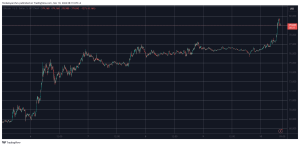In the past several years, the global crypto Anti-Money Laundering (AML) compliance solutions market has grown remarkably, reaching $686.89 million in 2023. As Verified Market Research reports, this sector is expected to surpass $1 billion by 2025, with a projected compound annual CAGR of 17.6% from 2024 to 2031. Such a swift expansion reflects the increasing mainstream adoption of crypto and the critical need for robust AML compliance solutions to combat illicit activities in the space. As cryptocurrencies integrate into the global financial system, the demand for effective AML tools becomes more urgent.
Global Crypto AML Compliance Solutions Market Estimates and Forecast (USD Million), 2022-2031 (Source: Verified Market Research)
Key Drivers of AML Market Growth
The more individuals and institutions engage with digital assets, the higher transaction volumes are, which creates a heightened risk of money laundering or terrorism financing. This surge in activity necessitates more sophisticated and scalable AML solutions to monitor and mitigate these risks effectively – and they are definitely underway.
Currently, the integration of AI and machine learning is transforming the field of AML compliance in the cryptocurrency industry. These technologies provide the means for AML solutions to analyze vast amounts of transaction data, identifying complex patterns indicative of money laundering that would be challenging for traditional methods to uncover. AI and ML continuously learn from data and improve the accuracy and efficiency of detecting suspicious activities. Companies like Chainalysis, AMLBot, and Elliptic are at the forefront of utilizing artificial intelligence for the purpose of AML compliance. Chainalysis deploys AI-driven tools to reinforce transaction monitoring, facilitating the identification of high-risk transactions and offering more profound insights into the movement of funds on the blockchain. Elliptic employs machine learning algorithms to enhance the detection of illicit activities while reducing the occurrence of false positives.
AMLBot is also leveraging the power of AI to improve its anti-money laundering capabilities. The platform is developing tools to categorize and analyze cryptocurrency addresses, identifying groups of addresses associated with specific activities, such as over-the-counter (OTC) desks or darknet markets. These pattern recognition features exceed the capabilities of human analysis, enabling the detection of previously unseen connections. Also, in the future, AMLBot’s AI engine will aggregate data from multiple AML sources, reconciling conflicting information to provide a unified and accurate assessment of risk.
The shifting regulatory framework is another factor driving the growth of the AML compliance market. Governments and regulatory bodies worldwide are increasingly recognizing the importance of establishing clear guidelines for crypto transactions. Regulators are implementing new and clarified rules, compelling crypto businesses to adopt stringent AML practices.
These regulatory changes are boosting the demand for compliance solutions and encouraging advancements in the field. Companies are developing new products and services to meet the evolving needs of the market.
AML in High-Risk and New Crypto Environments
The exponential growth of the DeFi sector has created a new frontier for AML compliance. DeFi platforms, with their borderless and distributed nature, present some new challenges for traditional AML methods. This has spurred the development of specialized AML solutions tailored to the DeFi ecosystem and focused on monitoring decentralized transactions.
A prime example of the need for AML in the DeFi space is the recent memecoins surge. These often speculative digital assets, typically launched without a legal entity, highlight the gaps in traditional AML frameworks. BEER, a notable exception, demonstrated a strong commitment to compliance: they implemented KYC procedures by AMLBot for its presale audience.
This proactive approach is commendable given that most memecoins operate without such safeguards. The reason for this discrepancy lies in the decentralized nature of DeFi, where regulatory oversight is still developing. While some memecoin projects have implemented KYC, the vast majority prioritize speed to market over compliance, often operating as short-lived ventures without a formal legal structure. BEER’s example serves as a valuable blueprint for the industry, showcasing that responsible AML practices can be integrated even in the high-risk memecoin space.
The Road Ahead for AML Compliance in Crypto
The projected growth of the AML compliance solutions market reflects a broader shift towards greater accountability and transparency. As the market expands, developers and investors must remain vigilant and proactive in adopting cutting-edge AML tools to safeguard their operations and maintain regulatory compliance.
For developers, this growth means an increasing need to integrate robust AML protocols into their platforms from the outset. Whether launching new tokens or building DeFi applications, ensuring compliance with evolving regulations will be essential to long-term success. For investors, the highlighted trends underscore the importance of due diligence when engaging with crypto assets. The market matures, and only projects that prioritize AML compliance will stand the test of time.
Disclaimer: This article is provided for informational purposes only. It is not offered or intended to be used as legal, tax, investment, financial, or other advice.












